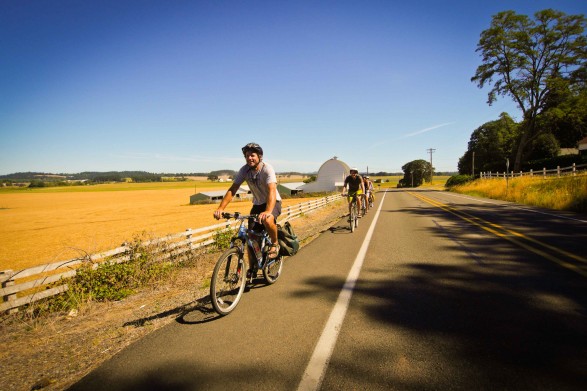
(Photo: Russ Roca/The Path Less Pedaled for Travel Oregon)
Two Portland-based grassroots groups are biking to Salem this month in an echo of the tactics that built pressure for Oregon’s 1971 bike bill.
Organizers for BikeLoudPDX and Livable Streets Action say they’re responding to Oregon’s 42 percent increase in roadway fatalities in the last two years.
“If 700 people died in a crash or collision as a one-time event, the state would prioritize everything that could be done to prevent this kind of tragedy happening,” said Soren Impey, BikeLoudPDX’s direct action coordinator. “But over the past two years, this is what’s happened, and there hasn’t been what we believe is an appropriate type of response.”
Oregon’s 2015 traffic fatality increase was the largest in the country, and fatalities in first half of 2016 have climbed higher still.
After years of declines, 796 people died on Oregon roads during 2014 and 2015. Oregon’s 2015 increase of 27 percent was the largest increase in the country, and state officials say the trend can’t be explained simply by more people being on the roads.
About 16 percent of those who died were on foot, and another 1 percent were on bicycles.
As of June 28, the fatality count for 2016 is rising higher still.
Organizer Gerald Fittipaldi said a group of riders will meet at 7 a.m. on Saturday, July 16 at Pioneer Courthouse Square.
“We’ll be going at a pretty slow pace,” Fittipaldi said. “So we’ll be getting to Salem in the late afternoon, and we’re going to have a rally there. Take photos, have signs, that sort of thing.”
The route isn’t yet determined, but it’ll include some of the Willamette Valley Scenic Bikeway. Celebrating the state’s investment in multi-city bikeways is a secondary goal of the ride, Impey said.
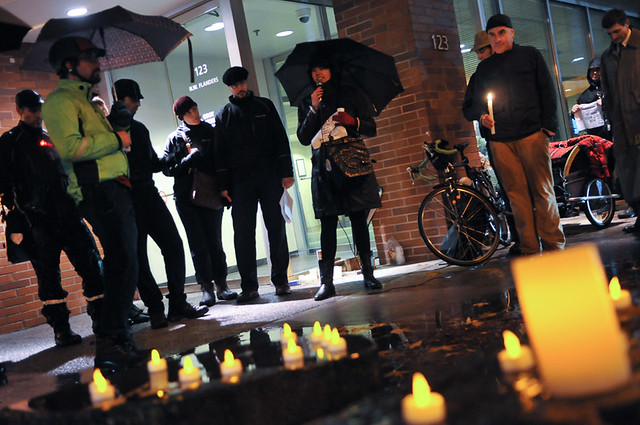
(Photo: J.Maus/BikePortland)
BikeLoudPDX is a Portland-based group founded in 2014 that cut its teeth on a campaign for less auto traffic on neighborhood greenways. This led to a new city program that’s adding diverters and speed bumps around the city. Livable Streets Action is an affiliated group that has led direct actions focused on reducing traffic violence.
“This is the kickoff to a campaign that we hope will continue for some time, up until the 2017 legislature goes into session.”
— Soren Impey, BikeLoudPDX and Livable Streets Action
Impey said the groups can’t achieve their goals without change at the state level.
“Part of this is the kickoff to a campaign that we hope will continue for some time, up until the 2017 legislature goes into session,” Impey said. “The goal is to have future events and future rides leading up to the legislative session so we can try to communicate to Oregon legislators and the governor that there is real grassroots, citizen-led support for funding active transportation.”
Impey said the state’s politicians and other leaders must act to shift priorities at the Oregon Department of Transportation.
“Most of the fatal crashes in Portland occur on high-crash corridors, many of which are run by ODOT,” Impey said. “ODOT, the state, has been dragging its feet on safety improvements for decades.
“The other big issue locally in Portland is speed,” he continued. “Speed is a major contributor to fatal crashes. Once again the state, ODOT, is a real barrier to decreasing speed limits to safe levels on dangerous roads in Portland.”
Advertisement
Fittipaldi said BikeLoudPDX and Livable Streets Action got the concept from rides organized by the Bike Lobby, a Portland-based biking advocacy group in the 1970s. The group, led by Portland State University English professor Sam Oakland, drafted a bill that imagined dedicating a fixed portion of state highway revenues to biking infrastructure.
That concept became a cornerstone of House Bill 1700, the narrowly approved measure widely acknowledged to have made Oregon the state with by far the highest rate of bike transportation.
BikeLoudPDX, too, is preparing a “draft bill” that they plan to vet among other allied groups. It outlines three policies:
1. Safety first — funding for safety improvements should be prioritized on facilities where safety metrics are not met.
2. Fully fund active transportation according to the Oregon Bicycle and Pedestrian Plan (Scenario 4).
3. Dedicate a percentage of STIP and Oregon Connect funding to bicycle and pedestrian safety improvements.
The groups are also in contact with other advocacy groups in Portland and Salem, and hope to get in touch with possible allies in Eugene, Corvallis and elsewhere.
“This is our first ride,” said Fittipaldi. “So we’re trying to build coalitions. We think the ride itself will help get us connected.”
The Facebook event for the ride is here.
— Michael Andersen, (503) 333-7824 – michael@bikeportland.org
Our work is supported by subscribers. Please become one today.



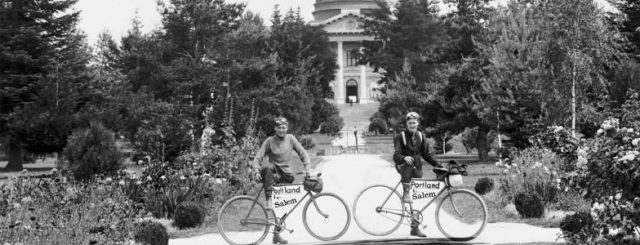
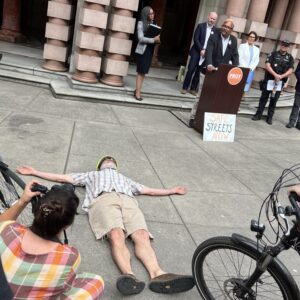

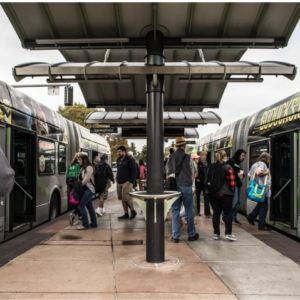
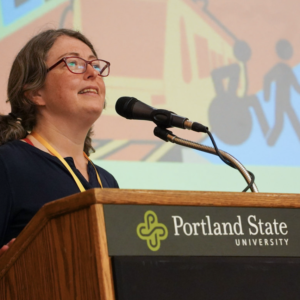
Thanks for reading.
BikePortland has served this community with independent community journalism since 2005. We rely on subscriptions from readers like you to survive. Your financial support is vital in keeping this valuable resource alive and well.
Please subscribe today to strengthen and expand our work.
I would add a fourth policy to the proposed bill:
4. On any high-crash corridor, the state shall maintain traffic law enforcement at a level that brings the crash rate down to below the state average.
I’m sure this wording could be dramatically improved. My point is that the primary reason our roads are so deadly is that motorists fail to obey the law. There is no more effective way to encourage safe driving than by creating a system that guarantees citations for scofflaw driving.
As I’ve said before, back when Davis, CA was the Bike Capital of the World (late-’70s to early-’80s) it had extensive traffic enforcement. You pretty much couldn’t break the law with your vehicle (bike or car) without getting a ticket. You couldn’t even park slightly out of compliance (like facing the wrong way on a short cul de sac) without getting a ticket. The result of this was that bikes outnumbered cars on the road by at least three to one, since much of the advantage of cars goes away when one must drive legally.
B. Carfree you make a strong point about enforcement (and by extension legal reform). This is definitely an issue that both Livable Streets Action and BikeLoudPDX care about and want to advocate for. It’s also more complicated since it involves multiple law enforcement jurisdictions, DA offices, and the legal system. And as we have seen many times on BP, we already have state laws that are not enforced well at the local level.
Given the attention focused on state funding (https://visionpanel.files.wordpress.com/2016/05/one-oregon-final-report-print-version2.pdf) and road safety (ODOT’s adoption of Vision Zero) we believe there is real opprtunity to advocate for road safety funding before the 2017 legislative session.
PS: I believe you live in Eugene so it would be cool if you could suggest some groups or people we could talk to about this campaign.
Yes, I live in Eugene, the only city that I know of that has seen a dramatic reduction in cycling over the past few years (down 37% 2009-14). As such, there really isn’t much in the form of effective groups to work with since the larger existing groups, GEARs and Safe Routes to School, have been “captured” by the city government and are not interested in rocking any boats. There are a couple of nascent neighborhood-level things starting up to fill the void, but the numbers are small (kind of like our cycling participation numbers). 🙁
That said, I’ll see what I can dig up and pass it off to bikeloudPDX. And if you see a couple on a silver tandem with a female captain at the ride, come over and say hello. I hope we can clear the day and ride on up, although we may have to join the ride somewhere after the beginning. (Hey, it takes a few hours to ride from Eugene to PDX so it’s tough to make a 7:00 AM start.)
Sounds a lot like the BTA.
Thanks B. Carfree. We’d love to have you on the ride. If you can muster up a couple of Eugene folks, one option would be to bike from Eugene to Salem (at least part of the way), and meet up with us in Salem. But if you can make it all the way up to Portland that would be awesome as well.
Within the next week or so we will have a better idea of exactly what time we will be rallying in Salem, but it should be roughly in the 3-5pm range. If you’re on Facebook, feel free to “like” the Livable Streets Action page. Otherwise, please send us an email at livablestreetsaction@gmail.com and we will include you on any updates. Thanks.
When we post the ride route we will have a midday regroup/join point closer to Salem.
Lowering speed limits is a laudable goal, but with no local enforcement, changing the numbers on signs is meaningless.
The best way to motivate the enforcers is to pay them direct cash commissions on speeding, phone use, and other violations that they write up. Yes, I’m saying make sure that individual cops get a cut of every ticket.
Will self-driving cars integrated into the traffic infra have to comply with speed limits? And if they do, why is it that manual driving cars are allowed to go faster than the fastest posted speed limit?
You touch on one of the beauties of self-driving cars. When they start getting on the road, they will create clusters of vehicles that are at or below the speed limit on two-lane roads and perhaps even on roads with more lanes. This in and of itself may change many people’s horrid driving habits as they cannot depend on being able to exceed the limit.
Thanks for the coverage, Michael. I just wanted to add that Dan Kaufman, founder of Livable Streets Action, has been putting significant legwork in working with Soren and I to figure out the details of the ride, and he helped direct the focus towards the 2017 legislative session. Thanks Dan!
A few observations:
1) The physicality of some corridors lends itself very poorly to increased enforcement so that will sometimes not be the preferred mechanism for improving things. In some places, more enforcement could cause more harm than good.
2) Trying to bring the crash rate below average everywhere makes no sense — it is mathematically impossible to make everything average or better.
1. Bike police and waving rows of drivers into a parking lot. 2. Make each spot better than average as you go, repeat. None of this is impossible, let alone difficult.
One goal could be to help fund, create, and build a statewide system of ped/bike trails separate from the highway system wherever physically possible. The gap in the Willamette Valley trail between Champoeg and Oregon City/Portland, which has existed for way too long, is a good example. With the National Bike Route network, including the Trans-Am Trail/Route 76, due to reach Oregon in the next few years, creating a statewide network becomes even more important. Adventure Cycling reports that WA State is expected to apply for at least three N/S routes for inclusion into the national network this fall. One of them will follow the I-5/Hwy. 99 corridor between Seattle and Vancouver. That means that the I-205 trail could be the continuation of that route into Oregon. Getting the wheels turning on getting a statewide ped/bike system built is therefore essential.
The national bike route system (USBRS) does not (and should not) require separated facilities. However it is interesting that Oregon currently has no one coordinating an effort to get routes designated for USBRS, at least according to Alex Phillips at the Oregon Parks & Rec Dept responsible for the Oregon Scenic Bikeway program.
Why not require them? Most recreation cyclists (and many who cycle for transportation) are not confident enough to cycle on any highway shoulder (no matter how large) without a physical barrier between them and >45mph traffic. And by “recreational cyclist” I am including people who stick to rails-to-trails, Sunday Parkways, and greenways, but would like to cycle on roads that actually get them somewhere (rather than closed tracks that are fun, but useless for intercity travel). In other words, the interested-but-concerned of cycling tourism. Why not have Springwater Corridors and I-205-paths connecting cities all around the state? I know I would love to get into cycling tourism here (something I really enjoyed in Japan), but not if it involves constant (or even occasional) vehicle traffic passing within 6 feet of me at 50-60mph.
Just like any bicycle infrastructure story, money! It’d cost too much for the level of user’s it’d see. I imagine the state is more inclined to support trail systems like the Springwater and Marine drive. Kind of a hodge-podge of disconnected trails, but used for all sorts of recreation. An interconnected trail system would be super nice for the bicycle tourist, but the areas way out of the “typical range” for the weekend user would hardly see any use.
Or maybe they’d see a tremendous amount of use because of the pent-up-demand for bike touring! But I doubt it…
I also seriously doubt it.
For a major route like along the coast or even to the coast, maybe, but even that is questionable given how low the use is for many of all but the most popular paths.
And barriers everywhere would not be a good thing
The Austrian section of the Danube River cycle path sees 630,000 users a year, with 55,000 biking the whole 200 miles from Passau to Vienna. http://www.donauradweg.at/en/danube-cycle-path.html
Just as a country Austria has a population density almost 3 times as large as the US. Access to that path from Austria alone is huge, not to mention adjoining countries. Would a path along the Platte river in Nebraska see the same usage?
Such averages are deceiving. Sure, the average density in the US is low, largely owing to our huge area of uninhabited and nearly uninhabited land. However, where people live the density is plenty urban. In fact, the average density that Americans live in isn’t far off what Austrians live in.
On the topic of protected tourist loops, I’m half in favor. We have some awesome roadways that don’t require any protection, but we have far too many pinch-points that make any loop unpleasant even for those of us with massive experience on the road. I feel that if we corrected those pinch-points/lines we could attract hundreds of thousands of bike tourists per year to loops that include PDX, Bend, the coast, Eugene and more and it wouldn’t even be prohibitively expensive.
Of course, acknowledging that there is demand to ride distances longer than a few miles without driving somewhere to do it would be a paradigm change for Oregon, but it’s a change that could reap huge rewards.
It does mean something when they are talking about the National Bicycle route system. 2000 miles on the Danube with a town every 5 miles means I can bicycle tour with my wallet, finding lodging and food with ease. A national system in the US has much greater obstacles for the rider.
J.E.
Why not require them? Most recreation cyclists (and many who cycle for transportation) are not confident enough to cycle on any …
Because for motorists “Out of Sight is Out of Mind!” As per drivers manual (at least it used to be) Pedestrians, Horses and Bicycles have priority on roadways.
If a cyclist is visible in a motorists windshield, steer clear at least 30 inches away from the cyclist or pedestrian, Horse, or cyclist at a closing speed not over 10 MPH. Interstate freeways without fog lines or emergency lanes are the only exemption.
You’re living in a fantasy world if you think cyclists have priority on state highways. Just try riding down Powell Boulevard and see what happens. What’s “on the books” has no implication on real life without infra and enforcement.
AFAIK the Willamette Valley bikeway is entirely on roads shared with motor traffic, amounting to nothing more than signs and a map. Why even call it a bikeway? Much of Oregon’s scenic “bikeways” follow this model, with the worst offender being the Oregon Coast route — literally nothing but the shoulder of Highway 101. This allows the state to pretend to be bike-friendly and reap all the benefits the bike tourism brings without actually doing anything. Sound familiar?
If they want to improve cycle touring, they could make roads designated as bikeways safe for their entire length. I’ve ridden the Willamette Valley Bikeway, huge chunks of 101, to the coast, and frankly I see no difference between designated cycle routes and other roads I might choose to take. Most of these roads are decent, but they all have some sections that are not for the faint of heart.
Fixing even small sections — for example adding a shoulder to bits of 101 that have no shoulder on blind curves — would be stupid expensive, but at least it would noticeably improve safety in these areas where a lot of cyclists get to deal with RVs driven by people watching the scenery rather than the road.
A dorky helmet mirror is your best friend on 101. Ridden the entire route and I don’t know how many times I pulled over because I saw an RV and semi barreling down the road. It sucks to have to pull over, but I always felt safe.
Honestly, I will never ride on these roads unless I’m with a considerably large group that can take the entire lane. There really needs to be a car-free option because I’m sure many others would also love to see Oregon’s beauty by bike and not have to fear for their lives.
Even the entire route from Portland to Eugene would likely be cheaper than the recently completed 2-mile Sunrise Corridor highway project. Sunrise Corridor was $130M for 2.15 miles ($60M per mile). The 21 mile Banks-Vernonia trail cost $1.4M ($66K per mile). It’s roughly 120 miles from Portland to Eugene, so assuming construction costs are similar, a fully car-free multi-use trail would cost an estimated $8 million. Roughly 6% of the cost of a new highway and covering 60 times more distance.
Anyone who tells you cycling infra is too expensive is lying or flat out misinformed. ODOT always seems to find the funding for new highways and roadway “improvements” but when it comes to active transportation infra, ODOT forces everyone to fight over scraps. This needs to stop. We have plenty of money for bike infrastructure.
Actually, that’s already reasonably safe. When you’re out in the sticks, traffic density is low enough that it’s easy to tell what’s going on.
As someone who has ridden between Portland and Eugene on I-5, 99, and other routes, I don’t think lack of cycling infrastructure is what keeps people from going between those points by bike. It’s just the sheer distance and the fact that it’s basically a flat ride where you’re likely to encounter a lot of wind.
When you get in actual scenic areas, traffic is not that big a deal but the lack of support or services is. Finding water is a pain, you need to carry a lot of food, and cell phones don’t work.
We plan on documenting this and posting updates online as we ride.
Yes !
It looks like a beautiful trail and I absolutely believe we could replicate such a system in Oregon if there’s widespread support. As far as numbers go, only 8% of users are interacting with the trail as an interconnected system, which is impressive considering the trail is 200 miles in distance. With Oregon being an active outdoor state, I wonder if we’d see higher user rates or less?
Those interested in transportation safety would do well to engage in ODOT’s draft Transportation Safety Action Plan.
Review the draft here:
https://www.oregon.gov/ODOT/TD/TP/Pages/tsap.aspx
Comments are being accepted through August 1 at safety@odot.state.or.us
Thanks Evan. This is one document we’ve been reviewing. It’s very pertinent and contains lots of material.
Today at 2:00pm BikeLoudPDX is hosting a pedalpalooza ride called New Orleans Jazz Funeral Ride. The start point is at Portland City Hall. The event consists of walking the first mile with our bikes to the ODOT headquarters. Then there will be a ride.
For more info: http://www.shift2bikes.org/cal/#02-5697
Feel free to RSVP on Facebook: https://www.facebook.com/events/544207535763702/
This is a lead-in event to the Salem Ride + Rally. The purpose of the event is to memorialize those who have been killed on Oregon’s roads.